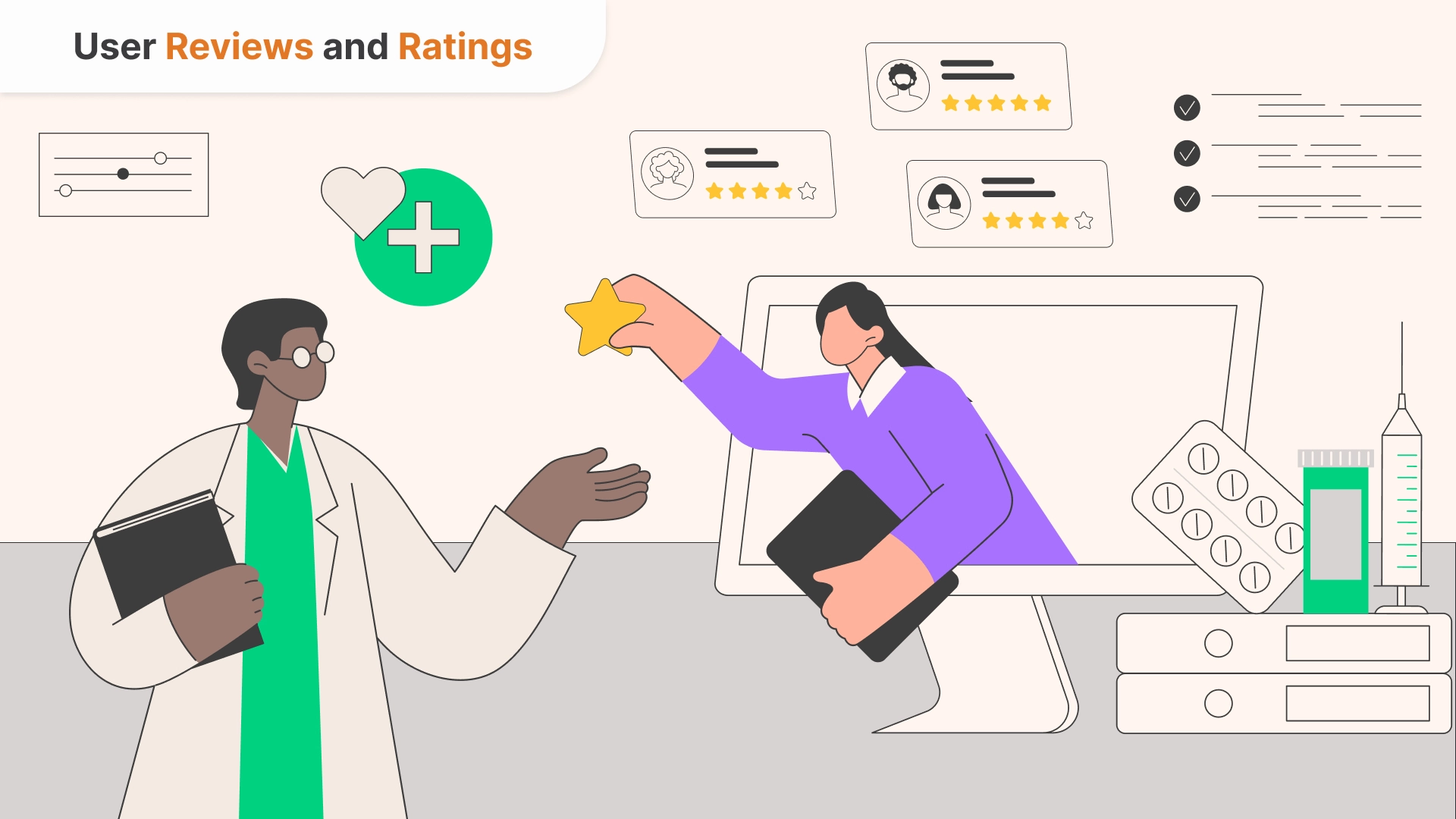

10 Must-Have Healthcare Software Features for Your Telemedicine App
- #1. Easy and Secure User Registration and Authentication
- #2. Comprehensive and Customizable User Profiles
- #3. Smart and Flexible Appointment Scheduling
- #4. Reliable and High-Quality Video Conferencing
- #5. Electronic Health Records (EHR) Integration
- #6. Prescription Management and Delivery
- #7. Patient Monitoring and Feedback
- #8. Secure Messaging and File Sharing
- #9. Data Analytics and Integration
- #10. User Reviews and Ratings
- In Conclusion
Telemedicine, the use of digital and telecommunication technologies for providing and receiving medical services remotely, has become increasingly popular and essential. This trend has been especially pronounced in the wake of the COVID-19 pandemic, which underscored the need for accessible, convenient, and safe healthcare delivery.
Telemedicine apps offer numerous benefits for both patients and providers. These include:
reducing the risk of exposure and transmission of infectious diseases;
saving time and money by eliminating the need for travel and waiting;
improving access to quality care for people in rural or underserved areas;
enhancing patient engagement and satisfaction through personalized and interactive care;
increasing efficiency and productivity for healthcare providers by streamlining workflows and reducing administrative tasks;
supporting the management and treatment of chronic conditions through continuous monitoring and feedback;
facilitating collaboration and coordination among different healthcare professionals and organizations.
However, not all telemedicine apps are created equal. To stand out in the competitive market, telemedicine apps need to incorporate certain features that ensure a high-quality, secure, and user-friendly experience for both patients and providers. This article discusses the 10 must-have healthcare software features for your telemedicine app and how they can enhance your solution.
#1. Easy and Secure User Registration and Authentication
A telemedicine app’s first step is to allow users to register and create profiles. This process should be straightforward, quick, and secure, requiring only essential information and verifying the user’s identity and credentials. For patients, this might include their name, email, phone number, date of birth, insurance details, and medical history. For providers, necessary information includes their name, email, phone number, license number, specialty, and affiliation.
The registration and authentication feature should also ensure the security and privacy of user data through encryption, passwords, biometrics, or other methods. This prevents unauthorized access, data breaches, and identity theft, which could have severe consequences for both patients and providers.
#2. Comprehensive and Customizable User Profiles
After registering, users should be able to create and update their profiles with relevant and accurate information. This feature should allow customization according to their preferences and needs, like choosing their preferred language, timezone, payment method, and notification settings.
The profiles should provide comprehensive and up-to-date information about the user’s health status, medical records, prescriptions, allergies, and other details. This helps users track their health history and progress and share it with their providers when necessary. For providers, profiles should display their availability, ratings, reviews, and other information to attract and retain patients.
#3. Smart and Flexible Appointment Scheduling
A key function of a telemedicine app is to enable users to schedule and manage their appointments online. This feature should be user-friendly, allowing users to view, book, cancel, or reschedule appointments with ease. Users should be able to see the availability and schedule of their preferred providers and filter them by location, specialty, rating, or other criteria. The feature should also integrate with the user’s calendar, email, phone, or other apps to avoid conflicts and ensure synchronization.
#4. Reliable and High-Quality Video Conferencing
The cornerstone of any telemedicine app is enabling users to have real-time video consultations with their providers. This feature should be reliable and high-quality, offering smooth, clear, and uninterrupted communication. Users need to see and hear their providers well and share their screens, images, documents, or files as needed.
#5. Electronic Health Records (EHR) Integration
Integrating with electronic health records (EHR) is another crucial feature. This allows users to access, update, and share their EHR with their providers and import or export them to other platforms or devices. It helps maintain consistency and accuracy in EHR, improving health outcomes and care quality.
#6. Prescription Management and Delivery
Managing and receiving prescriptions online is an essential feature. Users should be able to view, renew, or refill their prescriptions, choose their preferred pharmacy, and track their medication delivery. This feature should also offer alerts and reminders for medication adherence.
#7. Patient Monitoring and Feedback
Enabling users to monitor their health status and provide feedback is invaluable. They should measure and record their vital signs, symptoms, mood, and pain using their smartphone or wearable devices. Providers can then offer feedback, guidance, and support, improving health management.
#8. Secure Messaging and File Sharing
Secure communication is crucial for exchanging information between users and providers. This feature should allow encrypted messaging and file sharing, maintaining confidentiality and integrity in patient-provider communications.
#9. Data Analytics and Integration
Leveraging data analytics and integrating with other systems and platforms like CRM, ERP, or IoT enhances the app’s functionality. It should generate insights and predictions based on health data, using advanced techniques like AI and machine learning.
#10. User Reviews and Ratings

Another beneficial feature of a telemedicine app is to enable users to provide and receive reviews. It should allow users to rate their providers or services, based on their experience, satisfaction, or outcomes, using stars, numbers, or words.
All the features should also be secure and compliant with the relevant regulations and standards, such as HIPAA, GDPR, or HITECH, to protect the confidentiality and integrity of the user's data and communication. This can prevent eavesdropping, hacking, or leaking of sensitive information, which can compromise the user’s privacy and trust.
In Conclusion
Telemedicine apps offer numerous advantages for patients and providers alike. To succeed in this dynamic market, applications need to incorporate features that ensure high quality, security, and user-friendliness. This article has outlined 10 critical features that can significantly enhance your telemedicine solution.
For those looking to develop or upgrade a telemedicine app, BeKey provides expert services in software development and integration. We offer bespoke, scalable, and compliant solutions that cater to your specific needs. Reach out to us for a consultation, and let’s work together!
Faq
What are the essential features that a telemedicine app should have?
+A telemedicine app should have a user-friendly interface that allows patients to easily navigate and access healthcare services. Essential features include secure video conferencing for virtual consultations, a messaging system for communication between patients and healthcare providers, and a system for scheduling appointments and managing medical records. Additionally, it should ensure data privacy and security compliance, such as adherence to HIPAA regulations in the U.S., to protect sensitive patient information.
How does remote consultation work in a telemedicine app?
+In a telemedicine app, remote consultation works by allowing patients to connect with healthcare providers through digital platforms, typically using video calls, voice calls, or messaging. Patients can discuss symptoms, receive diagnoses, and get treatment recommendations, often including prescriptions. The app securely stores medical records and may integrate with other healthcare systems for seamless information sharing and follow-up care.
What is the importance of secure messaging in a telemedicine app?
+Secure messaging in a telemedicine app is important for protecting patient confidentiality, as it ensures that sensitive health information is not accessible to unauthorized individuals. It helps in maintaining compliance with healthcare regulations like HIPAA, which mandate the protection of patient data. Additionally, secure messaging fosters trust between patients and healthcare providers, encouraging more open and honest communication about health issues.
Tell us about your project
Fill out the form or contact us

Tell us about your project
Thank you
Your submission is received and we will contact you soon
Follow us
